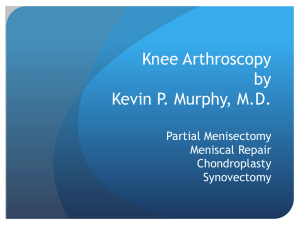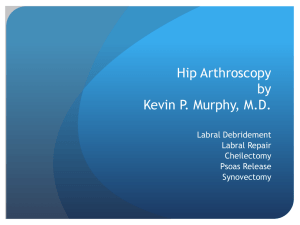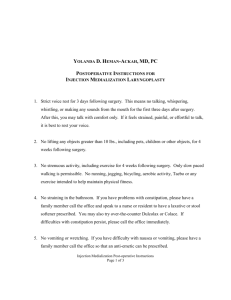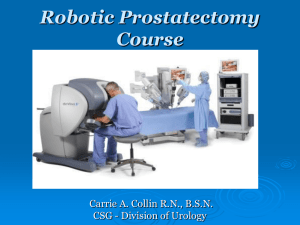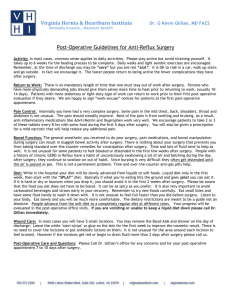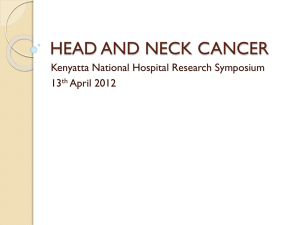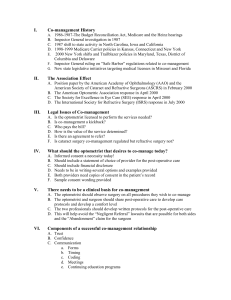post-operative instructions major surgery with inpatient overnight stay
advertisement
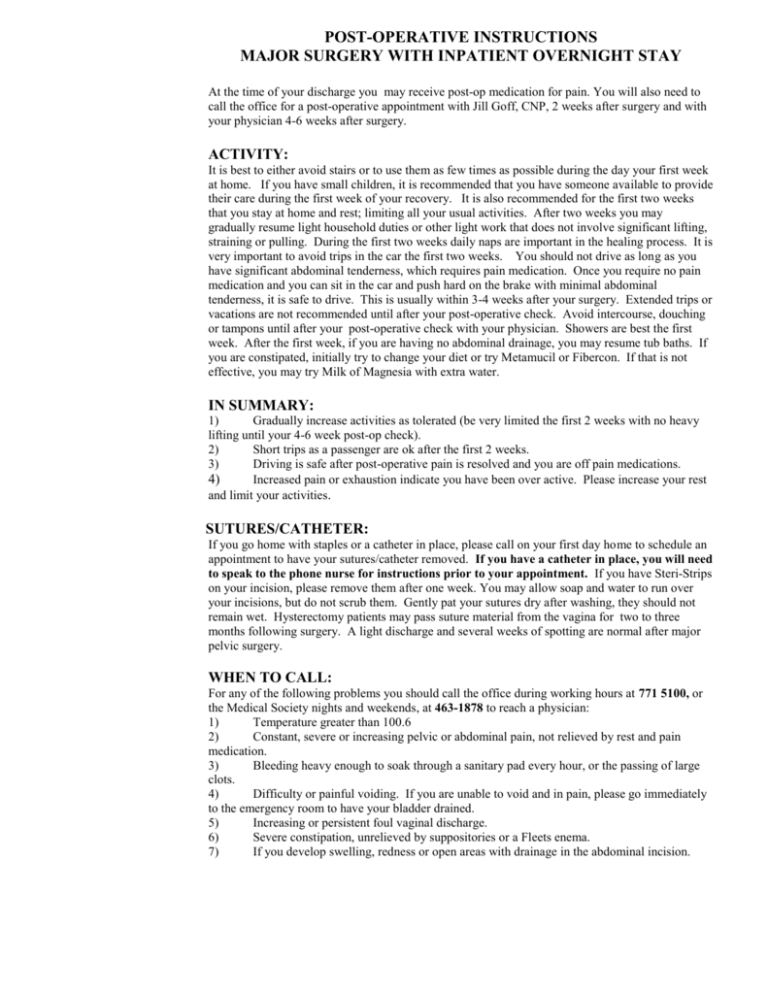
POST-OPERATIVE INSTRUCTIONS MAJOR SURGERY WITH INPATIENT OVERNIGHT STAY At the time of your discharge you may receive post-op medication for pain. You will also need to call the office for a post-operative appointment with Jill Goff, CNP, 2 weeks after surgery and with your physician 4-6 weeks after surgery. ACTIVITY: It is best to either avoid stairs or to use them as few times as possible during the day your first week at home. If you have small children, it is recommended that you have someone available to provide their care during the first week of your recovery. It is also recommended for the first two weeks that you stay at home and rest; limiting all your usual activities. After two weeks you may gradually resume light household duties or other light work that does not involve significant lifting, straining or pulling. During the first two weeks daily naps are important in the healing process. It is very important to avoid trips in the car the first two weeks. You should not drive as long as you have significant abdominal tenderness, which requires pain medication. Once you require no pain medication and you can sit in the car and push hard on the brake with minimal abdominal tenderness, it is safe to drive. This is usually within 3-4 weeks after your surgery. Extended trips or vacations are not recommended until after your post-operative check. Avoid intercourse, douching or tampons until after your post-operative check with your physician. Showers are best the first week. After the first week, if you are having no abdominal drainage, you may resume tub baths. If you are constipated, initially try to change your diet or try Metamucil or Fibercon. If that is not effective, you may try Milk of Magnesia with extra water. IN SUMMARY: 1) Gradually increase activities as tolerated (be very limited the first 2 weeks with no heavy lifting until your 4-6 week post-op check). 2) Short trips as a passenger are ok after the first 2 weeks. 3) Driving is safe after post-operative pain is resolved and you are off pain medications. 4) Increased pain or exhaustion indicate you have been over active. Please increase your rest and limit your activities. SUTURES/CATHETER: If you go home with staples or a catheter in place, please call on your first day home to schedule an appointment to have your sutures/catheter removed. If you have a catheter in place, you will need to speak to the phone nurse for instructions prior to your appointment. If you have Steri-Strips on your incision, please remove them after one week. You may allow soap and water to run over your incisions, but do not scrub them. Gently pat your sutures dry after washing, they should not remain wet. Hysterectomy patients may pass suture material from the vagina for two to three months following surgery. A light discharge and several weeks of spotting are normal after major pelvic surgery. WHEN TO CALL: For any of the following problems you should call the office during working hours at 771 5100, or the Medical Society nights and weekends, at 463-1878 to reach a physician: 1) Temperature greater than 100.6 2) Constant, severe or increasing pelvic or abdominal pain, not relieved by rest and pain medication. 3) Bleeding heavy enough to soak through a sanitary pad every hour, or the passing of large clots. 4) Difficulty or painful voiding. If you are unable to void and in pain, please go immediately to the emergency room to have your bladder drained. 5) Increasing or persistent foul vaginal discharge. 6) Severe constipation, unrelieved by suppositories or a Fleets enema. 7) If you develop swelling, redness or open areas with drainage in the abdominal incision. POST-OPERATIVE INSTRUCTIONS STRESS INCONTINENCE PROCEDURE At the time of your discharge you may receive post-op medication for pain. You will also need to call the office for a post-operative appointment with the nurse practitioner, 2 weeks after surgery and with your physician 4-6 weeks after surgery. See instructions below if you are discharged with a catheter. ACTIVITY: It is best to either avoid stairs or to use them as few times as possible during your first week at home. If you have small children, it is recommended that you have someone available to provide their care during the first week of your recovery. It is also recommended for the first week that you stay at home and rest; limiting your usual activities. Avoid intercourse, douching or tampons until after your post-operative check with your physician. Showers are best the first week. After the first week, you may resume tub baths. If you are constipated, initially try to change your diet or try Metamucil or Fibercon. If that is not effective, you may try Milk of Magnesia with extra water. After one week, you may resume normal activities. However, you should avoid heavy lifting until after your one month check-up. IN SUMMARY: Gradually increase activities as tolerated during the first week. You may return to work after one week. Driving is safe after post-operative pain is resolved and you are off pain medications. Increased pain or exhaustion indicates you have been over active. Please increase your rest and limit your activities. Avoid heavy lifting for the first 4 weeks post-operatively. SUTURES/CATHETER: If you go home with a catheter in place, please call on your first day home to schedule an appointment to have your sutures/catheter removed. If you have a catheter in place, you will need to speak to the phone nurse for instructions prior to your appointment. You may allow soap and water to run over your incision, but do not scrub. A light discharge and several weeks of spotting are normal after surgery. WHEN TO CALL: For any of the following problems you should call the office at 771-5100. Temperature greater than 100.6 Constant, severe or increasing pelvic or abdominal pain, not relieved by rest and pain medication. Bleeding heavy enough to soak through a sanitary pad every hour, or the passing of large clots. Difficulty or painful voiding. If you are unable to void, please go to the emergency room to have your bladder drained. Increasing or persistent foul vaginal discharge. Severe constipation, unrelieved by suppositories or a Fleets enema. POST-OPERATIVE INSTRUCTIONS PELVIC REPAIR/UROGYNECOLOGIC SURGERY At the time of your discharge you may receive post-op medication for pain. You will also need to call the office for a post-operative appointment with Jill Goff, CNP, 2 weeks after surgery and with your physician 4-6 weeks after surgery. See instructions below if you are discharged with a catheter. ACTIVITY: It is best to either avoid stairs or to use them as few times as possible during the day your first week at home. If you have small children, it is recommended that you have someone available to provide their care during the first week of your recovery. It is also recommended for the first two weeks that you stay at home and rest; limiting all your usual activities. After two weeks you may gradually resume light household duties or other light work that does not involve significant lifting, straining or pulling. During the first two weeks daily naps are important in the healing process. It is very important to avoid trips in the car the first two weeks. You should not drive as long as you have significant abdominal tenderness, which requires pain medication. Once you require no pain medication and you can sit in the car and push hard on the brake with minimal abdominal tenderness, it is safe to drive. This is usually within 3-4 weeks after your surgery. Extended trips or vacations are not recommended until after your post-operative check. Avoid intercourse, douching or tampons until after your post-operative check with your physician. Showers are best the first week. After the first week, if you are having no abdominal drainage, you may resume tub baths. If you are constipated, initially try to change your diet or try Metamucil or Fibercon. If that is not effective, you may try Milk of Magnesia with extra water. Patients may pass suture material from the vagina for one to two months following surgery. A light discharge and several weeks of spotting are normal after urogynecologic surgery. IN SUMMARY: Gradually increase activities as tolerated (be very limited the first 2 weeks with no heavy lifting until your 4-6 week post-op check). Short trips as a passenger are ok after the first 2 weeks. Driving is safe after post-operative pain has resolved and you are off pain medications. Increased pain or exhaustion indicates you have been over active. Please increase your rest and limit your activities. Avoid heavy lifting for the first 6 weeks post-operatively. CATHETER: If you have a catheter in place, you will need to call the phone nurse for instructions for removal of the catheter and scheduling a catheter check/bladder ultrasound appointment. WHEN TO CALL: For any of the following problems you should call the office during working hours at 771-5100, or the Medical Society nights and weekends, at 463-1878 to reach a physician: Temperature greater than 100.6 Constant, severe or increasing pelvic or abdominal pain, not relieved by rest and pain medication. Bleeding heavy enough to soak through a sanitary pad every hour, or the passing of large clots. Difficulty or painful voiding. If you are unable to void and in pain, please go immediately to the emergency room to have your bladder drained. Increasing or persistent foul vaginal discharge. Severe constipation, unrelieved by suppositories or a Fleets enema. If you develop swelling, redness or open areas with drainage in the abdominal incision.


